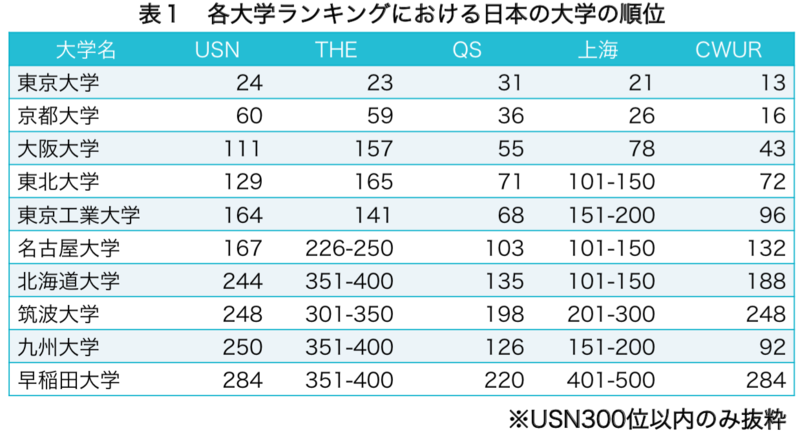U.S.News & World Best Global Universities Rankingsに思う 〜何が評価されているのか〜
1位ハーバード、東大24位 米誌が世界大学ランキング:朝日新聞デジタル
米誌のUSニューズ・アンド・ワールド・リポートは28日、世界の大学ランキングを初めて公表した。トップは米国のハーバード大で、上位10校のうち8校は米国の大学が占めた。日本からは、東京大学がアジアの大学として最も高い24位で、京都大学が60位に入った。
同誌は米国の大学ランキングを毎年公表している。世界ランキングはトムソン・ロイター社による「研究での信頼度」の調査や、引用が多い論文の数、博士号を得ている大学院生の数などから決定したという。
新しい大学ランキングのニュースが出ていました。記事の元になったランキングは、Top World Universities | US News Best Global Universities - US Newsです。U.S.News & Worldは以前から米国内の大学ランキングなどを発表していましたが、今回初めて世界規模でランキングを公表したようですね。大学ランキングについては、弊BLOGでも下記の通り言及してきました。
- 大学ランキングに思う - 大学職員の書き散らかしBLOG
- U-Multirankに思う 〜新たなランキングの現状と可能性〜 - 大学職員の書き散らかしBLOG
- 世界大学ランキングに思う 〜何が評価されているのか〜 - 大学職員の書き散らかしBLOG
今回出た大学ランキングはそれまでのものとどのように違うのでしょうか?

まず、日本の大学の順位を確認します。図1に、USNの300位以内にある日本の大学の各大学ランキングにおける順位を示します。なお、分野別ではなく総合順位を示します。CWURとは、サウジアラビアにある世界大学ランキングセンターが実施する大学ランキングです。指標に留学生比率等が含まれていないため、非英語圏の大学でも上位に入ると言われています。
表1から、各大学の順位関係はどのランキングでも概ね同じようである一方、ランキングによっては順位がだいぶ異なることがわかります。
そもそも、USNのランキングはどのような指標で計算されたものなのでしょうか。How U.S. News Calculated the Best Global Universities Rankings - US Newsで確認します。

表2に、USNランキングにおける指標と全体へのウェイトを示します。以降、それぞれを細かく見ていきます。
冒頭にある2指標はThomson ReuterのAcademic Reputation Surveyの結果を用いたようです。同調査結果は、Times Higher Educationのランキングにも使用されていますね。Regional research reputationはあまり聞いたことがありませんが、研究者の地理的バランスを考慮し、作成されたようです。
Global research reputation (12.5 percent): This indicator reflects the aggregation of the most recent five years of results of the Academic Reputation Survey for the best universities globally for research.
世界的な研究の評判(12.5%):これは、直近5年間の研究に関する世界的な評判調査の結果を反映しています。
Regional research reputation (12.5 percent): This indicator reflects the aggregation of the most recent five years of results of the Academic Reputation Survey for the best universities for research in the region.
地域的な研究の評判(12.5%):これは、各地域における直近5年間の研究に関する世界的な評判調査の結果を反映しています。
いわゆるビブリオメトリクス的な指標については、2008年から2012年までの5年間にWeb of Scienceに掲載された論文がベースになっているようです。
Publications (12.5 percent): This is a measure of the overall research productivity of a university, based on the total number of scholarly papers (reviews, articles and notes) that contain affiliations to a university and are published in high-quality, impactful journals.
論文数(12.5%):review、articleなど、大学が出した全ての学術論文数。
Normalized citation impact (10 percent): The total number of citations per paper represents the overall impact of the research of the university and is independent of the size or age of the university; the value is normalized to overcome differences in research area, the publication year of the paper and publication type.
標準化した被引用指数(10%):論文あたりの引用数の合計は、大学の研究の全体的なインパクトを示しており、規模や歴史とは無関係である。この値は、研究分野や出版年度、出版形態により標準化されている。
Total citations (10 percent): This indicator measures how influential the university has been on the global research community. It is determined by multiplying the publications ranking factor by the normalized citation impact factor. Total citations have been normalized to overcome differences in research area, publication year of the paper and publication type.
総被引用指数(10%):この指標は、大学が国際的な研究コミュニティーにどれほど影響を与えられたかを測定する。これは、標準化された被引用指数に出版物のランキング指標を乗じて決定される。総被引用数は、研究分野や出版年度、出版形態により標準化されている。
Number of highly cited papers (12.5 percent): This indicator reflects the number of papers that have been assigned as being in the top 10 percent of the most highly cited papers in the world for their respective fields.
高被引用論文数(12.5%):この指標は、各分野における被引用数上位10%の論文数を反映している。
Percentage of highly cited papers (10 percent): This indicator is the percentage of a university's total papers that are in the top 10 percent of the most highly cited papers in the world (per field and publication year).
高被引用論文数割合(10%):この指標は、大学の総論文数のうち各分野各年度の被引用数上位10%にある高被引用論文数の割合を示す。
International collaboration (10 percent): This indicator is the proportion of the institution's total papers that contain international co-authors divided by the proportion of internationally co-authored papers for the country that the university is in.
国際連携(10%):この指標は、機関の総論文数のうち国際共著論文数の割合を示す。
Number of Ph.D.s awarded (5 percent): This indicator reflects the total number of doctoral degrees awarded in 2012.
博士号授与数(5%):この指標は、2012年に博士号を授与した数を反映している。
Number of Ph.D.s awarded per academic staff member (5 percent): This is the number of Ph.D.s awarded per the number of academic faculty members for the same year.
教員数に対する博士号授与数(5%):この指標は、2012年における教授団の人数における博士号授与数の割合を示す。
これらの指標を基に、標準化等しながら、最終的には0−100までのグローバルスコアを算出したようです。なお、被引用数の算出等に用いたInCitesには芸術及び人文系の論文が含まれていないため、ビブリオメトリクスを用いた指標からは芸術及び人文系は除かれているようです。
ざっと指標を確認しましたが、かなり研究寄りのランキングであると想像できます。大学院への留学生などには、参考になるランキングなのかもしれません。